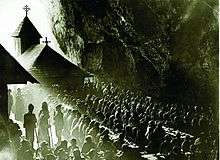Iosif Berman



Iosif Berman (January 17, 1892 – September 17, 1941) was a Romanian photographer and journalist during the interwar period.
Early life
Iosif Berman was born in Burdujeni, near Suceava to a Jewish father who had been awarded the Romanian citizenship for participating in the 1877 Romanian War of Independence.[1]
From an early age, Berman became interested in photography and as a child he spent time in the company of the itinerant photographers of Suceava and Cernăuți.[1] Before the age of 18, he moved to Bucharest, where he earned money to buy a camera.[2] His first photos were published in 1913 in the Dimineaţa depicting the cholera lazaretto from Turtucaia.[2] He continued working at the Adevărul and Dimineaţa newspapers, both of which were owned by left-wing activist Constantin Mille.[1]
During World War I, he was a regiment photographer and he was able to take photos of the October Revolution in Odessa, but his photographic plates were confiscated, on turns, by the Whites and by the Bolsheviks.[1][2] In 1918, he contributed to Realitatea Ilustrată with a set of photographs of the fleeing German Army.[2] After his regiment was disbanded, he traveled to Novorossiysk, in the Caucasus, where he met Raisa, whom he married and with whom he had a daughter, Luiza.[1]
Photojournalist
Between 1920 and 1923, he was a correspondent from Istanbul for the Romanian newspaper. After returning to Romania, he was a photographer for the major Romanian newspaper, taking photographs of the Royal Family.[1]
During the mid-1920s, Berman collaborated with sociologist Dimitrie Gusti, who studied the Romanian village and traditions, and with Filip Brunea-Fox for his reportage articles.[1]
His photographs were published in all the major Romanian newspapers of the time: Adevărul, Dimineaţa, Curentul, Realitatea ilustrată, România ilustrată, Ilustraţiunea română, Cuvântul liber, L'Indépendance roumaine and also in The New York Times and National Geographic, being a correspondent of the Associated Press and Scandinavian Newspaper Press.[1]
Fascist era
In 1937, the Octavian Goga government closed down the left-wing newspapers for which he worked and his life's work, the boxes with the photographic plates from the archive of the Adevărul and Dimineaţa newspapers were confiscated.[1] Nevertheless, he continued to work and to send photographs to The New York Times.[1]
Following the advice of Romanian historian and later Prime Minister Nicolae Iorga, Berman began using a pseudonym, I. B. Urseanu, (which is a translation of his Jewish name) in order not to attract the attention of the antisemitic Iron Guard.[1]
Nevertheless, in 1940, he was banned from continuing his work due to the Anti-Jewish laws which were enacted by the National Legionary State. Depressed, he soon died on September 17, 1941. According to his daughter, he succumbed to a renal disease for which he refused to get any treatment.[1]
Legacy
After World War II, the communist government tried to use the photos for propaganda, but they were hardly propaganda material. According to a researcher at Museum of the Romanian Peasant, he presented a realist view of the village, with its poor, its gypsies, its village idiot.[2]
Nevertheless, the photos were rediscovered after the Romanian Revolution at the Museum of the Romanian Peasant, which also published a monography on him. A documentary on his life and work was also made, called "Omul cu o mie de ochi" (The Man with a Thousand Eyes), directed by Alexandru Solomon.[2]
References
| Wikimedia Commons has media related to Iosif Berman. |